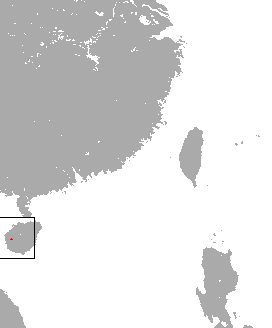Habitat
The Hainanus nomascus lives in Indochina thorughout the forest (Lok et. al 2008). All of the four subspecies of the H. concolor inhabit areas of China (Lok et. al 2008). The gibbons live in tall trees, about ten meters tall (Wikipedia 2014), in the moist forest into a suitable environment (Bleisch and Chen 1991). Their main environment they inhabit are primary forests, which acquire six species of plants the gibbons consume, with low amounts of gibbons living in secondary or dwarf forests. Primary forests are those that have never been disturbed before while secondary forests are recovering from one, which as a consequence lack the amount of nutrients needed to sustain large populations. Dwarf forests are those in which there are small trees because of the lack of nutrients provided in the soil to be able to grow to large heights (Wikipedia 2014).
Figure 4. This image shows the small amount of area that the Hainanus nomascus inhabit. From Wikipedia 2014.
The gibbon's habitat has been declining at an alarming rate. This deforestation has caused gibbons to be critically endangered (Bleisch and Chen 1991). The deforestation has resulted in the gibbon population to be reduced to the southwestern Yunnan and Hainan Island (Wang and Poirier 1988).
Figure 5. This image shows the different distribution of the gibbons in China. From Wikipedia 2014.
To learn more about the conservation of the gibbon and their environment click here.
Click here to continue to the adatations of the Hainan Gibbon or return to the homepage.

